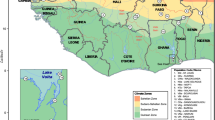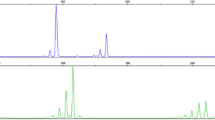Abstract
Four African wild strains (Egypt, Ghana, Senegal and Kenya) and four established Asian farmed strains of Nile tilapia, Oreochromis niloticus (popularly known in the Philippines as ‘Taiwan’, ‘Thailand’, ‘Singapore’ and ‘Israel’) were analysed electrophoretically at 30 protein loci to estimate genetic differences among the strains. All strains shared alleles at 14 monomorphic and 16 variable loci. Among the African strains, characteristic allele frequency differences were observed at AAT-1 * 46 for Ghana and Senegal, ADH * 83 for Kenya, ADH * 120 for Senegal, G3PDH-2 * 300 for Egypt, IDDH * 67 for Senegal, sMDH-1 * 120 for Kenya and SOD * 150 for Senegal. Genetic distance values among the strains revealed a clustering of the farmed strains with Egypt and Ghana O. niloticus, a slight separation of the Senegal strain and a larger separation of the Kenya strain. This profile may reflect the origins of the few founder populations of this species previously introduced to Asia. It also confirms the wider genetic divergence of the Kenya strain (O. niloticus vulcani) from the others studied here, which are all O. n. niloticus. Observed heterozygosities of the strains ranged from 0.026 to 0.071, with the African wild strains the lower values (mean Ho = 0.036) and the farmed strains the higher ones (mean Ho = 0.056). The implications of these results to the ongoing tilapia genetic improvement programme in the Philippines are discussed.
Similar content being viewed by others
References
Allendorf, F.W. and Utter, F.M. (1979) Population genetics. In: Fish Physiology, Vol. 8 (eds, W.S. Hoar, D.J. Randall and J.R. Brett) Academic Press: New York. pp. 407–454.
Bentsen, H. (1990) Application of breeding and selection theory on farmed fish. Proceedings of the Fourth World Congress of Genetics Applied to Livestock Production, Edinburgh Vol. XVI, pp. 149–158.
Clayton, J.W. and Tretiak, D.N. (1972) Amine-citrate buffers for pH control in starch gel electrophoresis. Canadian Journal of Fisheries and Aquatic Sciences 29, 1169–1172.
Eknath, A.E., Macaranas, J.M., Agustin, L.Q., Velasco, R.R., Ablan, M.C.A., Pante, M.J.R. and Pullin, R.S.V. (1991) Biochemical and morphometric approaches to characterize farmed tilapias. NAGA, The ICLARM Quarterly 14(2), 7–9.
Eknath, A.E., Tayamen, M.M., Palada-de Vera, M.S., Danting, J.C., Reyes, RA, Dionisio, E.E., Capili, J.B., Bolivar, H.L., Abella, T.A., Circa, A.V., Bentsen, H.B., Gjerde, B., Gjedrem, T. and Pullin, R.S.V. (1993) Genetic Improvement of Farred Tilapias: the growth performance of eight strains of Oreochromis niloticus tested in different farm environments. Aquaculture 111, 171–188.
Hallerman, E.M., Dunham, R.A. and Smitherman, R.O. (1986) Selection or drift - isozyme allele frequency changes among channel catfish selected for rapid growth. Transactions of the American Fisheries Society 115, 60–68.
Macaranas, J.M. (1991) A Practical Laboratory Guide to the Techniques and Methodology of Electrophoresis and Its Application to Fisheries Management. Fisheries Technology Manual No. 11. Philippine Council for Aquatic and Marine Research and Development.
Macaranas, J.M. and Fujio, Y. (1990) Strain differences in cultured fish - isozymes and performance traits as indicators. Aquaculture 85, 69–82.
Macaranas, J.M., Taniguchi, N., Pante, M.J.R., Capili, J.B. and Pullin, R.S.V. (1986) Electrophoretic evidence for extensive hybrid gene introgression into commercial Oreochromis niloticus (L.) stocks in the Philippines. Aquaculture and Fisheries Management 17, 249–258.
Maclean, J. (1984) Tilapia — the aquatic chicken. ICLARM Newsletter (1), 17.
McAndrew, B.J. and Majumdar, K.C. (1983) Tilapia stock identification using electrophoretic markers. Aquaculture 30, 249–261.
Nei, M. (1978) Estimation of heterozygosity and genetic distance from a small number of individuals. Genetics 89, 583–590.
Pante, M.J.R., Macaranas, J.M., Capili, J.B., Tayamen, M.M., Bimbao, M.A.P., Ablan, M.C.A. and Pullin, R.S.V. (1990) Development of research methods to evaluate Nile tilapia (Oreochromis niloticus) strains in the Philippines. Aquaculture 85, 324.
Pullin, R.S.V. (1985) Tilapias: ‘everyman's fish’. Biologist 32(2), 84–88.
Pullin, R.S.V. (1991) Cichlids in aquaculture. In: Cichlid Fishes: Behaviour, Ecology and Evolution (ed., M.H.A. Keenleyside) Chapman and Hall: London, pp. 280–309.
Pullin, R.S.V. and Capili, J.B. (1988) Genetic improvement of tilapias: problems and prospects. In: The Second International Symposium on Tilapia in Aquaculture (eds, R.S.V. Pullin, T. Bhukaswan, K. Tonguthai and J.L. Maclean) (ICLARM Conference Proceedings 15) Department of Fisheries, Bangkok, Thailand and International Center for Living Aquatic Resources Management, Manila, Philippines, pp. 259–266.
Pullin, R.S.V., Eknath, A.E., Gjedrem, T., Tayamen, M.M., Macaranas, J.M. and Abella, T.A. (1991) The Genetic Improvement of Farmed Tilapias (GIFT) project: the story so far. NAGA, The ICLARM Quarterly 14(2), 3–6.
Ryman, N. (1983) Patterns of distribution of biochemical genetic variation in salmonids: differences between species. Aquaculture 33, 1–21.
Seyoum, S. (1990) Allozyme variation in subspecies of Oreochromis niloticus (Pisces: Cichlidae). Isozyme Bulletin 23, 97.
Seyoum, S. and Kornfield, I. (1992) Identification of the subspecies of Oreochromis niloticus (Pisces: Cichlidae) using restriction endonuclease analysis of mitochondrial DNA. Aquaculture 102, 29–42.
Shaklee, J.B. (1983) The utilization of isozymes as gene markers in fisheries management and conservation. In: Isozymes: Current Topics in Biological and Medical Research, Vol. 11. Alan R. Liss: New York. pp. 213–247.
Shaklee, J.B., Allendorf, F.W., Morizot, D.C. and Whitt, G.S. (1990) Gene nomenclature for protein-coding loci in fish. Transactions of the American Fisheries Society 119, 2–15.
Smitherman, R.O., Dunham, R.A. and Tave, D. (1983) Review of catfish breeding research 1969–1981 at Auburn University. Aquaculture 33, 197–205.
Swofford, D.L. and Selander, R.B. (1989) BIOSYS-1: A Computer Program for the Analysis of Allelic Variation in Population Genetics and Biochemical Systematics. Release 1.7. Illinois Natural History Survey: Champaign.
Trewavas, E. (1983) Tilapiine Fishes of the Genera Sarotherodon, Oreochoromis and Danakilia. British Museum (Natural History): London.
Wohlfarth, G., Moav, R. and Hulata, G. (1975) Genetic differences between the Chinese and European races of the common Carp. II. Multicharacter variation — a response to the diverse methods of fish cultivation in Europe and China. Heredity 34, 341–350.
Wright, S. (1978) Evolution and the Genetics of Populations, Vol. 4. Variability Within and Among Natural Populations. University of Chicago Press: Chicago.
Author information
Authors and Affiliations
Rights and permissions
About this article
Cite this article
Macaranas, J.M., Agustin, L.Q., Ablan, M.C.A. et al. Genetic improvement of farmed tilapias: Biochemical characterization of strain differences in Nile tilapia. Aquacult Int 3, 43–54 (1995). https://doi.org/10.1007/BF00240920
Issue Date:
DOI: https://doi.org/10.1007/BF00240920




